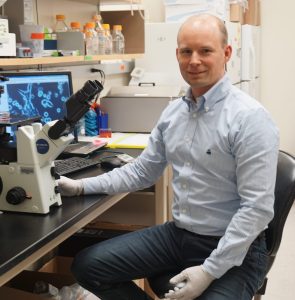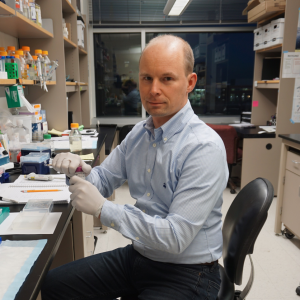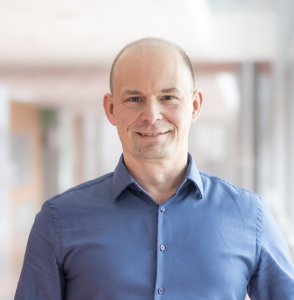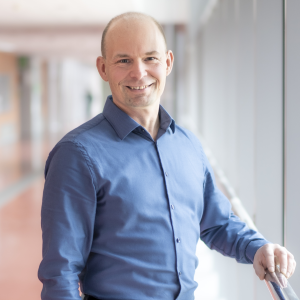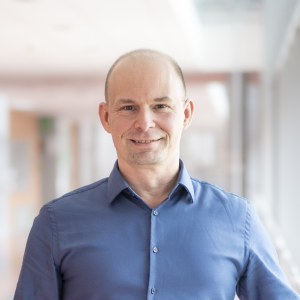
The newly created research group of Zdeňka Andrysíka. investigates the molecular mechanisms of tumours, with focus on the use of modulation of transcription factors’ activity in targeted oncological treatments. The group was created in the Brno node of NICR at the Institute of Biology (Faculty of Medicine, Masaryk University).
-
You are coming back to Czechia after a number of years. Would you have any recommendations for those who wish to leave, for instance for a postdoc stay?
I do. There are four main things they should think about. First of all, it is necessary to secure financing for the envisaged project for sufficiently long time. It is quite common that work on a good study takes four or more years. Asking one’s future head of a group or department about how long ahead they had secured grants or some other support for is a question that needs to be asked very soon. It is because it is a personal tragedy if you spend for instance two years of your life, many nights, weekends, etc. working on a project that is promising but then the lab runs out of money and its activity is discontinued before you can demonstrate your all that effort by published results.
The other criterion should be the quality of research done at a particular lab. That means not only the quality of journals where they publish but also the quality of their publications as such, the methods they use, and how they analyse and interpret the data. The third thing that should be considered are one’s personal intentions regarding career development after the postdoc stay. What do I want to do in five years and how can this or that lab help me achieve it? Do I want to stay abroad? Do I want to stay in academia or rather look for a position in a biotech company? Did the team leader support the career of his or her graduates or postdocs in the past?
And the last criterion for me was where should I go for a postdoc, that is, what does the lab do. I have come to believe that the thematic orientation of a lab is perhaps somewhat overestimated. In hindsight, it seems rather like when you do an experiment: Is it better to be open to unexpected results or to search, come what may, for data that support a solution that seemed most likely from the outset and seems to be most commonsensical?
-
How was the return to your ‘native soil’ for you as a researcher with several years of working abroad?
Given that I always wanted to return and was initially leaving with the notion of a two-year stay, I am really happy I managed to come back. It was just a combination of excellent conditions for my work and my desire to learn more by working on new projects that kept me back.
In this place, I would like to express my admiration of everyone who works in our science. Especially after returning from such a long time abroad, the leap ahead is very noticeable. Although – and it is like that everywhere – there are always things that could be improved or adapted to changing opportunities or social demand, we can be proud of what we have achieved here.
-
How could the NICR help further improve the conditions for cancer research in our country?
I am still at a stage where I am finding out how things work here but I hope I will not be stating the obvious if I mention two areas where I believe NICR could play a highly positive role. The first is in facilitating further sharing of capacities and abilities, both technological ones and expert knowledge. One could start for instance by creating one spot with links to centres of shared services, which NICR teams could use outside their home institutions, perhaps even under some sort of advantageous conditions. Such reference place would be also useful for identification of missing technologies and prevention of needless duplication of effort and money (editor’s note: such list has been created in the meantime and can be accessed on NICR website).
The other area would pertain, naturally, to the financing of projects of NICR laboratories. None of us is likely to be short of ideas for pilot studies. On the other hand, in the light of the amount of usually allocated resources, for instance in the standard grants of the Czech Science Foundation, it feels that in international comparison relatively little money is left for small exploratory studies. And yet, such studies can develop the core topic in an unexpected direction, and above all they can generate data needed for larger and less risky grant applications. In other words, it would be great if there existed low-threshold financing source that would not require extensive project preparation and whose failure in the form of non-confirmation of the initial hypothesis would not hurt the applicant’s reputation in any way.
-
Your research group investigates the molecular mechanisms of cancer. Could you tell us more about the methods you use and your research goals?
Let me start with the research goals: The aim of my lab’s work is to propose a targeted anti-tumour therapy based on a modulation of transcription factor activity. Transcription factors have long been neglected in this sense, because there were very few pharmacological means of influencing them. But that situation had fortunately changed.
The focus on transcription activity is logical because changes to this activity characterise almost all the different ways in which tumour cells differ from normal cells. That means that the tumour depends on the altered transcription, which is something we could in theory use. It also follows from the biological nature of tumour growth that, save for some rare cases, we will need to act on the tumour tissue in a combined fashion, because there are usually several changes that lead to malignities.
In my work, I try to integrate methods of molecular biology and mechanistic approaches to explaining the behaviour of cells and cell populations. We then verify these findings using 3D models and experimental animals. The goal is to eliminate tumour cells and minimise the negative effects of the therapy. All this should be then supported by an analysis of a database of tumour samples provided by patients.
-
When reading your publications, one cannot but notice that you focus especially on transcription factor p53. What makes it so interesting for you?
Transcription factor p53, coded by the TP53 gene, is utterly unique. It is the most frequently mutated tumour suppressor in our genome. Through other genes, whose transcription it stimulates, it exerts antitumour activity using a number of mechanisms. Aside from activating the gene of cell death (apoptosis), which is the much-desired goal of therapy, p53 also boosts the transcription of genes that halt cellular division, boost DNA repair, and initiate various metabolic changes or cellular differentiation. Unlike other transcription factors, moreover, p53 is quite conservative: it always binds to a similar set of regions in the genome. This is due to two of its properties. The first is the fact that the sequence of nucleotides, i.e., letters of the genetic code, which p53 requires to form a bond, is relatively long. As a result, it relatively accurately determines where p53 can interact with DNA. The other is the ability of p53 to unlock even inactive regions in the genome, meaning that it functions as a so-called pioneer transcription factor.
There exists a relatively long list of substances developed by several pharmaceutical companies that specifically activate p53, or rather block the breakdown of the p53 protein: that leads to its accumulation in the cells and increased activity. It is thus no accident that TP53 is the most frequently studies gene of all, although its biology is complicated and to this day, we do not have at our disposal antitumour therapy based on targeted p53 activation.
-
With your team, you work on a new therapeutic strategy based on acting on the p53 protein. What is the basic idea and how do you see its potential application in clinical practice?
I think that some unmet expectations and disappointment linked to substances activating specifically p53 should be viewed in the perspective of induction of p53 by natural stimuli, which lead to p53-dependent cell death. For instance, ionising radiation leads to extensive damage to DNA and subsequently to an apoptosis of tumour cells largely mediated by p53. On the other hand, such stimuli activate in the cells not only p53 but also other centres of stress response. Only a joint action of these centres then leads to an irreversible initiation of the processes that lead to cell death. In hindsight, we can thus say that it is not all that surprising that activation of just one of these centres, albeit a very potent one, namely p53, usually leads just to a reversible halting of the cellular cycle but rarely to apoptosis.
The core idea of the antitumour therapy I have designed and would like to further develop consists in a concurrent activation of two or more stress response systems. Aside from p53, it is the centre of integrated stress response (ISR), which usually redirects translation, i.e., the production of a protein based on template mRNA, from something like a ‘normal operation’ to a translation of mRNA genes needed for stress response. At first sight, it may seem that the idea of a therapy based on something like blocking the cellular ‘production’ of genes may be nonsense, because one does, after all, need new proteins to survive. Well, that is true, but tumour cells require an especially high constant supply of new proteins: tumour cells are due to their inefficient metabolism vitally dependent on a high intensity of translation. That creates a vulnerability that could be used in therapy. For instance, in late 1990s, one new drug approved for HIV treatment was nelfinavir (Viracept), which is an inhibitor of virus protease. Its side effect is induction of ISR and the abovementioned redirection of translation mechanisms, and it turned out that that did not lead to significant side effects for the patients.
We found a link between p53 and ISR during one mechanistic study, when we discovered negative feedback between the two centres of stress response, which we had interrupted using the abovementioned nelfinavir. The result was a heightened response to p53 activation and a massive apoptosis of tumour cells. In an experiment that used mouse models, we saw a similarly strong synergy: the tumours stropped growing, and all the experimental animals survived the entire duration of the therapy while in other groups, not a single one had survived.
I am not the only person to believe that this combination of substances is a very promising foundation for further improvement of targeted therapy and an important step to using the vast potential of induction of p53, the most important of tumour suppressors. On the other hand, one ought to be realistic in terms of clinical application. There is still a lot of work ahead of us and it has happened many times before that a promising concept had to be abandoned because the preclinical trial stage had not been sufficiently comprehensive.
-
What do you value the most among your scientific results or experiences?
Probably my most recent work, which I would like to develop further as a key research programme of my laboratory, but there are also other studies I like returning to. For instance, we managed to nicely map the network of genes controlled by p53 and HIF1A and create a concept based on which one can relatively reliably distinguish between directly and indirectly regulated genes. This is important for a better understanding of the general, conserved functions of individual transcription factors.
Regarding experiences, I would like to keep the naïve courage of a person who did not know that something is impossible and that is why he managed to do it. Professor Espinosa had recently told me that his favourite among our joint publications is a genetic screen based on a concurrent detection of two proteins controlled by p53, one nuclear, the other mitochondrial – using flow cytometry. When I proposed the project to him soon after my arrival to the laboratory, he thought I was mad, because to detect these proteins one would need two different methods of cell fixation, which should imply that they cannot be measured both at the same time. But he let me burn my fingers when I was not dissuaded by his doubts. Well, in the end I managed to finetune the detection protocol, carry out the experiment, and since that time I had his trust and a great deal of freedom in what I could do in the lab.
-
If it were just up to you, what would you, with your colleagues, like to achieve in research?
I would really like to get antitumour therapy based on targeted activation of p53 to the clinical trial stage.
-
Do you think it is important for a team to share more than ‘just’ research?
If collaborators can meet outside of their work, it is always a sign of a well-functioning team. It also depends quite a bit on how research is organised in the team. Based on my experience, I can say there is quite a wide range, from a clearly competitive environment all the way to a highly collaborative one. Some rivalry is certainly alright, but the notorious practice where two postdocs are assigned to one project and the one who solves the problem earlier is named as the first author of the joint publication is certainly bad. It shows no respect to people’s time and effort. And it leads to all sorts of problems. A good team leader needs to find some middle way. I believe it is better to adjust the project to a person’s motivation and abilities rather than the other way around.
One activity I would like to practice, if at all possible, within the lab, is some form of volunteer activity, for instance occasional involvement in the activities of nonprofit organisations such as the League Against Cancer. At least for me, a non-physician, such meetings are a valuable reminder of why we actually do what we do.


